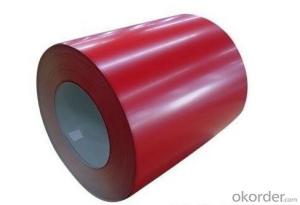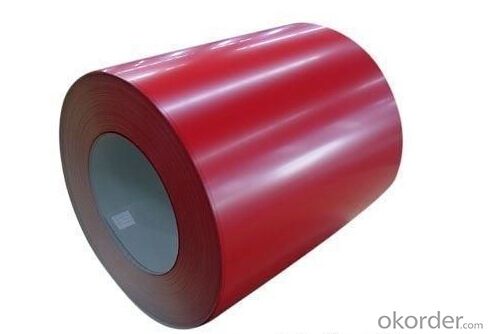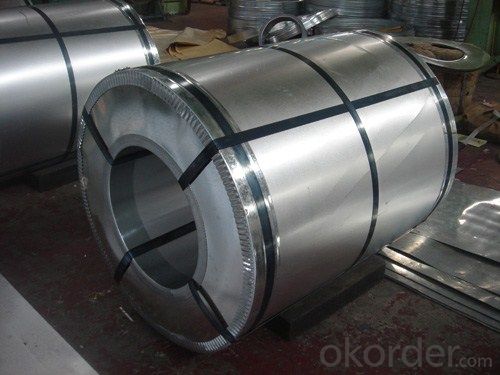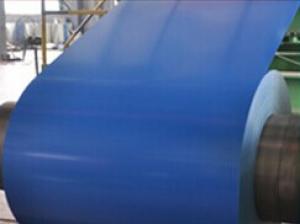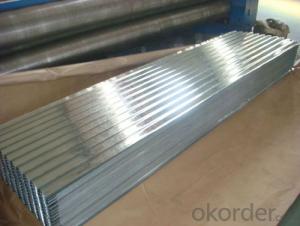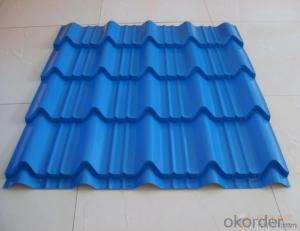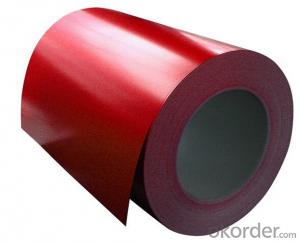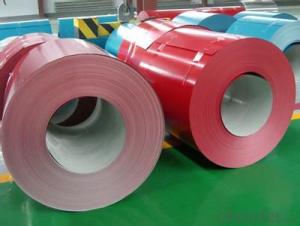Pre-Painted Galvanized/Aluzinc Steel Coil with Good Price
- Loading Port:
- Tianjin
- Payment Terms:
- TT OR LC
- Min Order Qty:
- 50 m.t.
- Supply Capability:
- 10000 m.t./month
OKorder Service Pledge
OKorder Financial Service
You Might Also Like
1. Pre-Painted Galvanized/Aluzinc Steel Coil Description:
With GI as base material, after pretreatment (degrease and chemical treatment ) and liquid dope with several layers of color, then after firing and cooling, finally the plate steel is called pre-painted galvanized (aluzinc) steel. Pre-painted galvanized steel is good capable of decoration, molding, corrosion resistance. It generally displays superior workability, durability and weather resistance.
2.Main Features of the Pre-Painted Galvanized/Aluzinc Steel Coil:
• Excellent process capability
• Smooth and flat surface
• Workability, durability
• Excellent heat resistance performance
• High strength
• Good formability
• Good visual effect
3.Pre-Painted Galvanized/Aluzinc Steel Coil Images
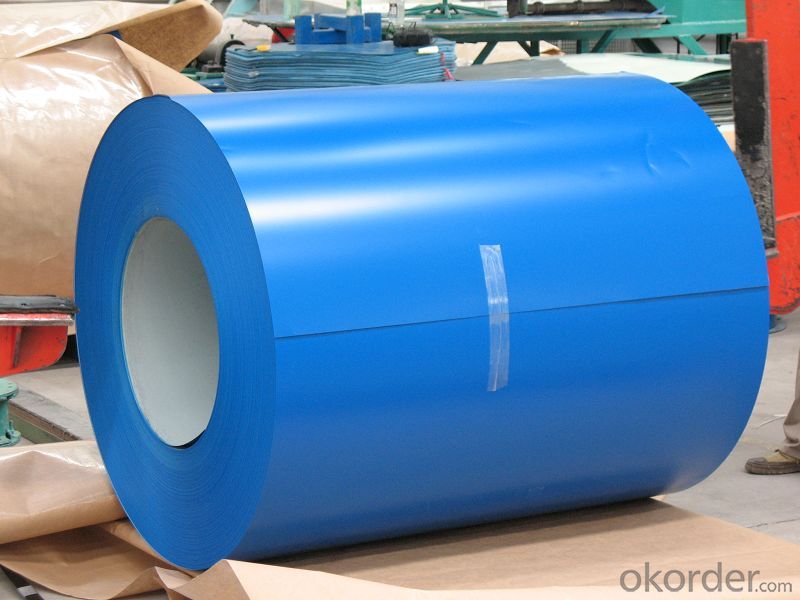
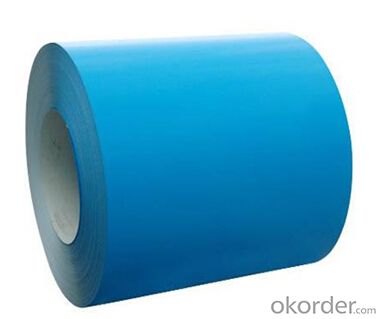
4.Pre-Painted Galvanized/Aluzinc Steel Coil Specification
Standard: AISI, ASTM, BS, DIN, GB, JIS
Grade: DX51D, DX52D
Thickness: 0.17-2.0mm
Brand Name: KMRLON
Model Number: coil
Type: Steel Coil
Technique: Cold Rolled
Surface Treatment: Coated
Application: Boiler Plate
Special Use: High-strength Steel Plate
Width: 20-1250mm
Length: customized
commoidty: pre-painted galvanized steel coil
Thickness: 0.13-4.0mm
width: 20-1250mm
zinc coating: 40-180g/m2
printing thickness: top side: 20+/-5 microns, back side: 5-7 microns
color: all RAL color
surface treatment: color coated
coil weight: 4-7 tons
coil ID: 508/610mm
packaging: standard seaworthy packing
5.FAQ of Pre-Painted Galvanized/Aluzinc Steel Coil
What’s the application of this product?
Roof, roof structure, surface sheet of balcony, frame of window, etc.
What’s the brand of the paint?
We use the best brand of all of the word—AKZO.
- Q: What are the different types of steel coils available?
- There are several different types of steel coils available, each with its own specific properties and uses. 1. Hot Rolled Steel Coils: These coils are produced at high temperatures and are commonly used in applications that require a smooth and polished finish, such as automotive parts, construction materials, and machinery. 2. Cold Rolled Steel Coils: These coils are processed at lower temperatures to improve the surface finish and dimensional accuracy. They are widely used in industries such as automotive, appliances, and electronics, where a high level of precision is required. 3. Galvanized Steel Coils: These coils are coated with a layer of zinc to protect the underlying steel from corrosion. They are commonly used in construction materials, roofing, and automotive parts that are exposed to harsh environmental conditions. 4. Stainless Steel Coils: These coils are made from a combination of iron, chromium, and other elements to provide excellent corrosion resistance and high strength. They are widely used in applications that require hygiene, such as food processing equipment, medical instruments, and kitchen appliances. 5. Electrical Steel Coils: These coils are specifically designed for applications that require magnetic properties, such as transformers, electric motors, and generators. They have low core losses and high permeability to efficiently transfer electrical energy. 6. Pre-painted Steel Coils: These coils are coated with a layer of paint or other protective coatings to enhance their aesthetic appeal and provide additional protection against corrosion. They are commonly used in the construction industry for cladding, roofing, and siding. 7. Tinplate Steel Coils: These coils are coated with a thin layer of tin to prevent corrosion and provide a barrier against moisture and oxygen. They are widely used in the packaging industry for cans, containers, and other food or beverage packaging. These are just a few examples of the different types of steel coils available in the market. Each type has its own unique properties and applications, making them suitable for various industries and purposes.
- Q: How are steel coils heat treated?
- Steel coils are heat treated using a process called annealing. Annealing is a heat treatment technique in which the steel coils are heated to a specific temperature and then slowly cooled down. This process helps to relieve any internal stresses within the steel, improve its mechanical properties, and enhance its overall performance. The heating process involves raising the temperature of the steel coils to a critical point, typically between 800°C and 900°C, depending on the specific grade and desired outcome. The coils are then held at this temperature for a specific period of time, allowing for the transformation of the steel's microstructure. Once the desired time has elapsed, the heated steel coils are slowly cooled down in a controlled manner. This slow cooling process is vital as it allows the steel to undergo a gradual transformation, resulting in a more uniform and refined microstructure. This controlled cooling also helps to minimize the formation of internal stresses, which can potentially weaken the steel. The annealing process can be performed in different atmospheres, such as air, nitrogen, or hydrogen. The choice of atmosphere depends on the specific requirements and properties desired for the steel coils. For instance, annealing in a protective atmosphere like nitrogen or hydrogen can help prevent oxidation or decarburization of the steel surface. Overall, heat treating steel coils through annealing is a critical step in enhancing their mechanical properties, improving their formability, and achieving the desired characteristics for various industrial applications.
- Q: How are steel coils inspected for surface cleanliness?
- Steel coils are inspected for surface cleanliness through a variety of methods including visual inspection, magnetic particle inspection, and ultrasonic testing. Visual inspection involves visually examining the surface for any visible contaminants or defects. Magnetic particle inspection uses magnetic fields and particles to detect surface defects such as cracks or flaws. Ultrasonic testing uses high-frequency sound waves to detect any subsurface defects or irregularities. These inspection methods ensure that the steel coils meet the required standards of cleanliness and quality.
- Q: could someone please explain to me in detail the functions of stainless steel wall ties?
- wall ties are used to tie brick coursing to the back up wall...stainless steel will simply last longer than the others but you will pay dearly for them...
- Q: My musical saw has, despite my best efforts, got little patches of rust on it. How Do I go about removing the rust without spending too much on rust-removal products and without affecting the properties of the steel?
- Steel wool and a bit of WD 40. Steel wool will remove the rust and the WD 40 will protect it in the future.
- Q: Does SA use its own iron ore to produce steel for construction or do we rely on imports?
- SA got its own steel and iron production going that is one of our main exports They don't make Rail's for railway line any more we in port it
- Q: How do steel coils contribute to the manufacturing of electrical appliances?
- Steel coils are essential components in the manufacturing of electrical appliances as they are used to create the core of transformers and electromagnets. These coils, made from steel, provide the necessary magnetic field required for the functioning of electrical appliances such as refrigerators, televisions, and washing machines.
- Q: Bronze came before steel, right? thanks
- Bronze The earliest surviving iron artifacts, from the 5th millennium BC in Iran and 2nd millennium BC in China, were made from meteoric iron-nickel. By the end of the 2nd millennium BC iron was being produced from iron ores from South of the Saharan Africa to China. Steel (with a smaller carbon content than pig iron but more than wrought iron) was first produced in antiquity. New methods of producing it by carburizing bars of iron in the cementation process were devised in the 17th century. In the Industrial Revolution, new methods of producing bar iron without charcoal were devised and these were later applied to produce steel. In the late 1850s, Henry Bessemer invented a new steelmaking process, involving blowing air through molten pig iron, to produce mild steel. This and other 19th century and later processes have led to wrought iron no longer being produced. The earliest tin-alloy bronzes date to the late 4th millennium BC in Susa (Iran) and some ancient sites in China, Luristan (Iran) and Mesopotamia (Iraq).
- Q: What are the challenges in coil leveling for high-strength steel?
- One of the main challenges in coil leveling for high-strength steel is the material's inherent strength and hardness. High-strength steel is designed to have superior mechanical properties, which can make it difficult to manipulate and flatten during the leveling process. The high tensile strength and increased yield strength of the steel can cause it to resist deformation, leading to springback or permanent deformation issues. Additionally, the increased hardness of the steel can put more strain on the leveling equipment, potentially leading to wear and tear. Proper equipment selection, precise control of leveling parameters, and advanced process monitoring techniques are required to overcome these challenges and achieve accurate and consistent coil leveling results for high-strength steel.
- Q: What is the average lead time for receiving replacement steel coils?
- The average lead time for receiving replacement steel coils can vary depending on various factors such as the supplier, location, and specific requirements. It is recommended to consult with the supplier or manufacturer directly to get an accurate estimate of the average lead time for receiving replacement steel coils.
Send your message to us
Pre-Painted Galvanized/Aluzinc Steel Coil with Good Price
- Loading Port:
- Tianjin
- Payment Terms:
- TT OR LC
- Min Order Qty:
- 50 m.t.
- Supply Capability:
- 10000 m.t./month
OKorder Service Pledge
OKorder Financial Service
Similar products
Hot products
Hot Searches
Related keywords
